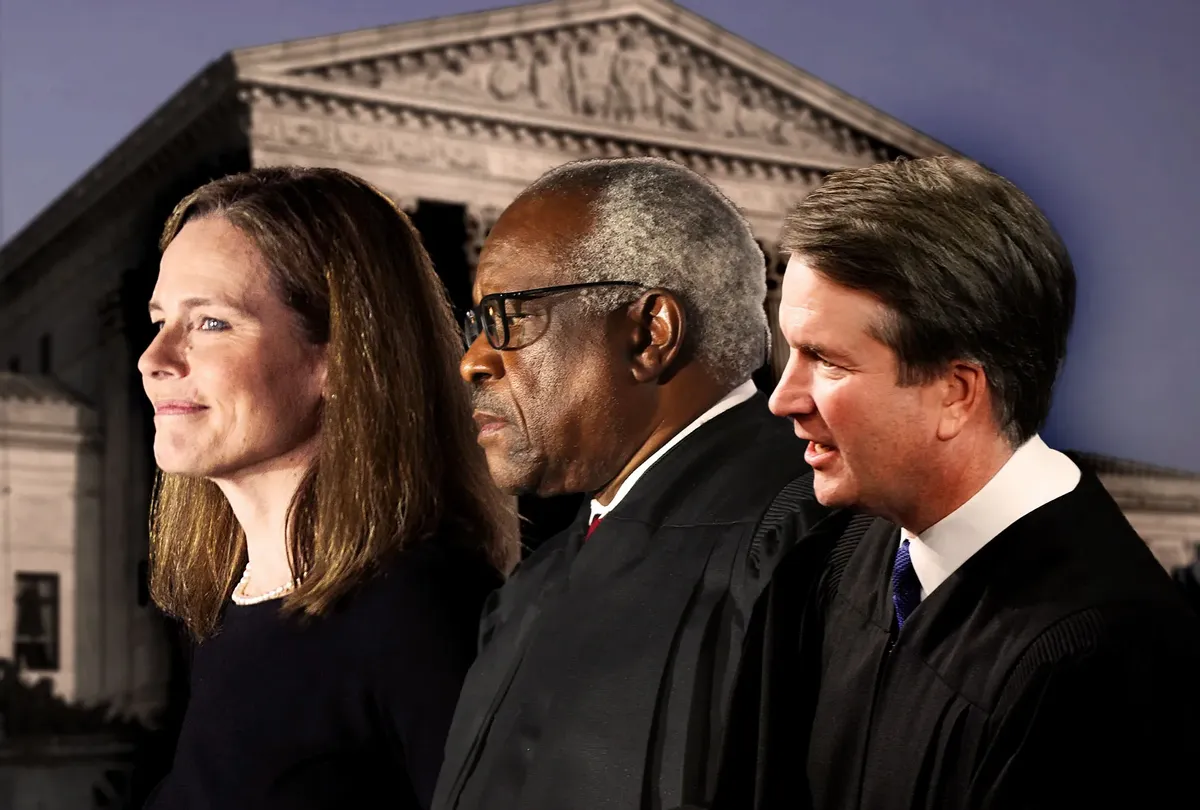Amid a time of so many domestic and international issues and areas of concern, the fact that the Supreme Court of the United States (SCOTUS) has recently gone on a radical-right wing agenda, American jurisprudential renovation spree should be amongst the most concerning innovations for this nation and its citizens. With a Legislative branch that only represents effectively in the lower House of Representatives, this effectively leaves the US with an increasingly conservative and reactionary reading of the Constitution and relevant present-day cases, and a Senate that is unwilling to break its longheld and antiquated procedural codes to rule in a majoritarian manner.
When attempting to discuss the Supreme Court in the United States today, it is as much a matter of knowing one’s history as having gone through the voting records of each of the justices that make up this highest of courts. These right-wing innovations did not appear from out of the blue, but have been worked into the system over decades of persistence, cajoling, manufactured victories and judicial appointments, and a massive, decades-long campaign to reimagine and, henceforth, to re-indoctrinate the American people, concerning how those who wrote the US Constitution imagined their document should be perceived and applied in future times.
There are levels to all of this, in other words, and that entails discussing not only how America has gotten to this point, despite that polls consistently show that the majority of the nation – alongside the three liberal justices on the court – disagrees with SCOTUS’s hardline rulings, but how even with things as they have come to be over the previous decades of this country’s history, there are positive ways forward all the same. To understand the way forward, however, it is important to know how America got here in the first instance.
Over the last 34 years, only twice has a Republican President won the popular vote in this nation – both by a Bush – and yet, in that 34-year period, 16 of those years have featured a Republican President as the leader of this country. That a party can remain Presidentially competitive with this type of horrendous recent record of results is the most obvious red flag concerning the broken nature of Presidential Elections in this nation, vis-a-vis outrageous, wholly outdated institutions like the Holy-Roman-Empire-inspired Electoral College.
Yet that is a discussion for another essay; while the Democrats have been in office for just two years longer as of this essay – a product merely of Joe Biden’s 2020 victory – they have nominated just three of the justices whom sit upon the nine-person Supreme Court bench: Justices Elena Kagan, Sonia Sotomayer, and Ketanji Brown Jackson are those names and individuals. Now, it would be reasonable to ask at this point, likely exasperatedly, how that could even be possible? And the answer, is that many things have had to occur for this American circumstance to be as we know it to be today.
The United States Senate as an institution should certainly be held responsible for at least two of those miss-appointed Justices – logically Brett Kavanaugh and Amy Coney-Barrett – but the SCOTUS itself has actually perpetuated its own conservative reactionary makeup and complexion as well; when that court essentially decided Florida and the Presidency for George W Bush in the Presidential Election of 2000, they also won two further seats that should have been otherwise appointed by former-Vice President, and actual Presidential victor in 2000, former Tenessee Governor and Science enthusiast Al Gore.
Justice Samuel Alito, as well as Chief Justice John Roberts, therefore, are, in many ways, as illegitimate as members of the Supreme Court as both Justices Brett Kavanaugh and Amy Coney-Barrett. With this stated, let it be further understood that this means that not two justices, but four, have been taken from the natural course of the people’s democratically voted will; in America today, far from the 6-3 conservative supermajority that exists upon the SCOTUS currently, there should be, in fact, a 7-2 liberal supermajority. Republicans have only fairly had the opportunity to nominate a new judge twice – under George H W Bush, which has resulted – despite Anita Hill’s bravery – in three decades of Justice Clarence Thomas, and when Justice Anthony Kennedy resigned in the middle of the lone term of Donald Trump.
Justice Neil Gorsuch would likely still be a SCOTUS Justice anyway, logically being chosen to replace Justice Anthony Kennedy instead of the late-Justice Antonin Scalia, who would have, in a sane and cooperative world, been replaced by the current Attorney General of the United States, Merrick Garland. Mitch McConnell and the Republican Senate hi-jacked that vote on purely ideological and partisan stances with over 200 days to go until the 2016 elections were to take place, and would act so dishonorably again by the end of the lone four-year Trump Presidency as well. Amy Coney-Barrett is the product of that further campaign of Senatorial hi-jacking meanwhile, when she was chosen to replace the late Justice Ruth Bader Ginsburg – who passed literally less than two months before the 2020 Presidential Election – in direct hypocrisy with the logic that was vocally used to justify withholding Barack Obama his chance to replace Antonin Scalia about five years prior.
In this specific scenario, and with the precedent of recent decisions and actions being taken into consideration, the choice of a new Justice should’ve been delayed until the results of the elections of that year were decided upon – as McConnell insisted regarding the Scalia-Garland debate. Given that Joe Biden won the 2020 election, it is reasonable to suspect that the newest Justice, Ketanji Brown Jackson, would have just months more experience on that court today than whoever Joe Biden selected to replace the most recently-retired Justice, Stephen Breyer.
And with a Supreme Court that more accurately reflected the will of the people – by almost every reliable metric – instead of the one we currently have, not only would the freedoms of so many Americans be safer and more well protected, but that body could stand even today as a bulwark against the likes of wannabe autocrats like the former, 45th President of the United States or his once-protege, the current Governor of Florida. Yet, again, that is not the SCOTUS that this nation has; instead, it has the one which ruled that states can control if a woman has an abortion within their boundaries but not if a person has a concealed handgun.
The story of how America has gotten here, however, also involves, other than Presidential Elections, nominating disputes, and the infamous Bush v. Gore, decisions that conservatives upon the court have carried out across those decades of work. That work, such as Citizen’s United v. FEC, District of Columbia v. Heller, Exxon Shipping Co. v. Baker, Shelby County v. Holder, Connick v. Thompson, as well as the recently decided Dobbs v. Jackson Women’s Health Organization, and New York State Rifle & Pistol Association v. Bruen, etc., has undoubtedly lead this country into the dark place it currently finds itself in; some justices, like Clarence Thomas and Samuel Alito, however, hinted that, actually, it could all get much darker still. In that same, malevolent vein, in these already-decided cases, those right-wing judges of each SCOTUS and era voted, when it meant the most, in what must be considered a great coincidence if it is not some coordinated, ideological proclivity, along what might be considered political, ideological lines, and in ways that either benefited conservative leaders, conservative ideology, or future conservative ambitions in some way.
Whether America can escape that dark place moving forward, will trully be a matter of if it can resolve the massive disconnects between the will and vote of the people and the execution of that will by the electoral process, of which flows into so many other channels of American life and governance. And while ending the practice of gerrymandering across the nation, eliminating the Electoral College, and breaking the Senate filibuster are good places to begin, expanding or “stacking” the SCOTUS, alongside certain other reforms, are also long-overdue innovations.
The size of America’s Supreme Court has not been fixed or set at any point in its history. In fact, its current unchanged run – since 1869 – is absolutely the longest historical run that body has ever experienced; the last real threat of any change came nearly 100 years ago during the early years of Franklin Delano Roosevelt’s second Presidential administration. He wanted to be able to pressure old justices into retiring with the threat that new justices could be added for each justice who refused to retire after hitting 70-years-old; while that attempt to “Pack the Court” famously failed, there are innovations that could and should be passed to refresh the court, even alongside any additional court expansion or appointments, of which we will shortly get to.
But, as history demonstrates, the conservative streak of the SCOTUS has long and widely been written about and, therefore, has been thoroughly documented. Whether it be concerning Chief Justice Taney’s comfortable little chat with newly inaugurated President James Buchannon just before the Dred Scott v. Sandford decision was to be announced, the Plessy v. Ferguson decision nearly forty years later, or else concerning the many problems that FDR had in the 1930s with the SCOTUS as he sought to create his New Deal, that court’s conservativity has, in fact, been one of the most noteworthy threads throughout great chunks of American history.
In the ensuing decades after FDR’s nation-changing Presidency, great strides were made across American culture and society, and the famous liberal Justices who served on the SCOTUS during that period have been recognized as titans of progress for so many millions of people. However, since the Reagan Presidency some forty years ago, SCOTUS jurisprudential decisions have steadily shifted more manically conservative than perhaps the nation has seen since the 1920s.
It was, to be sure, under Ronald Reagan and his successor, George H W Bush, that Originalism and many of the modern-day Originalist heroes would be made into SCOTUS justices who, in at least one instance, remains to rule over us still today. Names like the aforementioned Antonin Scalia, the recently retired Anthony Kennedy, and the well-known Sandra Day O’Connor, along with Thomas, helped to usher in this current era of the SCOTUS in which, to not at least passively admire Originalist ideas, might be enough to earn you the scorn of politicians and the media alike; Bush v Gore was a gift, in so many ways, to future Trumpian and DeSantian conservatives from the Reagan and Bush eras.
Which brings us back to our current time, place and question: How can the United States overcome its own SCOTUS and those supreme injustices of which it is now levying upon the nation and its people?
Today, thanks to the persistence of conservative SCOTUS Justices over these last 40 years, even a liberal Justice must, to some degree, repudiate the “living Constitution” concept of which both former-President Thomas Jefferson, as well as the Honorable Justice Oliver Wendell Holmes Jr. articulated so beautifully between 100 and 230ish years ago; this repudiation is ceremonial at this point, despite that the US Constitution does contain the ninth amendment that, to the trained and untrained eye alike, both articulates and intimates that the founders of this nation knew quite well that they would not be able to, in the late-18th century, craft a document of which could state coherent law for an untold future, predict the future itself, or any of those courses of events and innovations which progress inevitably brings.
Continuing from the logic utilized by both the former President and responsible American founder, as well as by the famous Supreme Court Justice of the early 20th century, the founders knew that the US Constitution was a living document, because they based it off of the “unwritten,” living document that is the English Constitution, which has survived upon precedents, as well as various differently written documents of law, for at least 1000 years to this point, by whatever metrics one would like to use.
In what could be considered irony from this modern perspective, the purpose that the American founders had in writing just one document in the first place was to ensure that many rights or freedoms were never abridged as a result of them not being explicitly remarked upon in any of a number of given documents across any particular time period; it was not meant to disclude rights not mentioned (again re: The Ninth Amendment). Yet the writing of such a document has actually done more to bind future Americans than to liberate them; those heirs of those founding Americans have, by and large, come to understand the US Constitution as more of an unchangeable holy document than as a basic blueprint or scaffolding to generally attempt to accommodate or follow, and hence, misunderstand its very core nature.
And so, as to remedy the supreme imbalance which, as we’ve noted, derives not from one source, but from many, there are at least three innovations to focus on concerning reform measures outside of making sure to vote consistently and with purpose up and down your ballot. While I am of the opinion that the court could simply be added to, either with eight or ten more members, without much loss of prestige for an institution that would still hold sway over just more than 300 million humans across America, age and term limits should also be enacted as clear and positive reforms of the court.
When SCOTUS appointments were first made as lifetime positions, it was thought that this could cut down upon the political pressure associated with the position, but how Justices often responded to that lifetime appointment was much different. Most justices didn’t stay on for more than a few years or a decade at max, given that people didn’t live nearly as long, the job was a chore, requiring lots of traveling, it didn’t pay great and also had little prestige associated with it. Needless to say that, in the decades and nearly two-and-a-half centuries later, all of which I mentioned has changed, and the reforms that fix the SCOTUS must acknowledge the historical nuances, as well as the current SCOTUS problem and its solution.
Reforms regarding age and term limits – as regarding the US Congress and the Electoral College – are widely popular no matter one’s ideological background, but court stacking, like in 1937, remains a hot-button and loaded topic and innovation to discuss. The natural inclination to imagine that the party suggesting the measure feels markedly disadvantaged often gives the appearance of sour grapes by that party, but age and term restrictions, I believe, would help to soften some of that pushback by eliminating the eternal aspect of the appointment; a 16 to 20-year term limit seems reasonable, as does a mandatory retirement age of somewhere between 60 and 70.
The combination of age and term limits, alongside an expansion of the court’s size itself, would make the court more representative of all of the people whom call this nation their home, would see a greater turnover of Justices than we currently do, and would create a sense of scheduled certainty – to some degree – around which Justices are nearing the end of their time on the court and which the next President – whoever is in charge – will get to appoint during his time in office.
Positive steps forward, like the aforementioned, must be made regarding the SCOTUS, and they must be made soon; for on their current course, they will be their own downfall. They will be chiefly responsible for pushing the nation towards the very innovations which they themselves would argue would then further discredit the court. The people of America will not tolerate their rights being taken from them, whether it be their right to control their own bodies, to feel safe within their communities, or to feel safe as who they are at their very foundational levels. With this understood, the SCOTUS and its Justices – for the sake of their own fragile egos – would do well to remember the words so eloquently and famously written by the Italian author Giuseppe Tomasi di Lampedusa in his novel, The Leopard, “If we want things to stay as they are, everything will have to change.”









